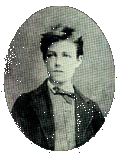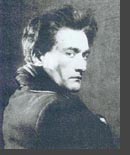r a n d a l l . p a c k e r
Net Art as Theater of the Senses
A HyperTour of Jodi and Grammatron
 As
though French poets Arthur Rimbaud and Antonin Artaud had just time traveled
into the future to the early days of Net art experimentation, two of the ground-breaking
projects on the web today, Jodi and Grammatron, revel in an intoxicated celebration
of the senses with a new form of interactive-networked-experiential-transcendental-
poetic-theater.
As
though French poets Arthur Rimbaud and Antonin Artaud had just time traveled
into the future to the early days of Net art experimentation, two of the ground-breaking
projects on the web today, Jodi and Grammatron, revel in an intoxicated celebration
of the senses with a new form of interactive-networked-experiential-transcendental-
poetic-theater.
While theater begins with the notion of the suspension of disbelief, interactive art picks up where theater (and film) leaves off with branching, user-driven non-linear narrative. The letting go of authorial control has been the big dilemma in the development of interactive works as an art and/or entertainment medium, games being the exception. Both Jodi and Grammatron energetically ignore the warning signs and head unabashedly into the danger zone of audience interaction / participation. Both works gain enormously from a kind of breathless urgency and surreal sensory distortion that might have been inspired by the performance art of Artaud, the poetry of Rimbaud, or even the transformative work of such contemporary digital artists as Laurie Anderson, Char Davies or Perry Hoberman.
"cyberspace is creating a new form of narrativity to get lost in"
Mark Amerika, mercurial author of Grammatron, editor of the web magazine alt-x, and a prodigy of Brown University where hypertext innovator George Landow spearheaded the hyperfiction movement, has expounded on the narrative possibilities in hyperfiction in his web-based article HyperText Consciousness (HTC). "HTC as experienced in cyberspace is creating a new form of narrativity to get lost in. This narrativity may be more hallucinogenric or clickual to the reader/participant, but it still has the feel of a narratologically-mind discourse." The branching discourse eventually alters our sense of the authorial center, a dissolution of self. Mark Amerika's mantra, "I link therefore I am," aside from the Cartesian allusions, seems strangely reminiscent of Rimbaud's own attempt to transcend the boundaries of self with his famous statement, "Je est un autre" literally, "I is an other."
Grammatron takes off with the curtain rising, an ominous soundtrack accompanies an overture of flipping pages with texts and animated images that have a frightening quality in their mechanical automation. The cyborgian credo "I am a writing machine," flashes across the screen followed by passages of delirious prose, the authorial voice now dissolving in the hypnotic sequence of turning pages. We sense the voice of a newborn automaton (further transformation of the authorial voice) attempting "to gain control over the movement of the letters, their meaning strung together here in this electronic writing space."
When the overture ends we find ourselves on the brink of hyperspace, a clearing where the branching tentacles begin connecting fragmented lexias (chunks of fiction) in the form of: ruminations, satiricims, datacisms (or dadacisms), eroticisms, declamations, singular nodes within the sprawling storyline. Gradually, we are introduced to the tangled web of the Grammatron world: Abe Golam, "legendary info-shaman," Nanoscript, "desire's own language..a forbidden data that had been permeating the electrosphere," Golam's avatar-sweetheart Cynthia Kitchen, the self-alienation of Digital Being, and the quest for creative immortality.
Like William Gibson science-fiction novels, including the legendary Neuromancer, the synthetic world of Grammatron, with its de-centered narrative, meandering story-threads, and immersive chaos, confuses and intertwingles (to use hypertext pioneer Ted Nelson's twisted language) real life, virtual sex, and the "search for God."
"we love your computer"*
"We are honored to be in somebody's computer" boast the Jodi authors Joan Heemskerk and Dirk Paesmans (hence the Jodi title), who have not only gone beyond the interface, they have abolished it. Jodi pages flash and burn, scrolling and displaying uncontrollable computer code, fragmented shards of interface elements (menus, buttons, etc...), code stripped bare of its functionality, a once symbolic language now transformed into a surreal magic theater of the absurd.
Heemskerk and Paesman attended Silicon Valley's electronic arts laboratory CADRE at San Jose State University, which is headed up by a master of subversion and parody, media artist Joel Slayton. According to the Jodi duo, "The computer presents itself as a desktop, with a trash can on the right and pull down menus and all the system icons. We explore the computer from inside, and mirror this on the net. When a viewer looks at our work, we are inside his computer. There is this hacker slogan: 'We love your computer'... You are very close to a person when you are on his desktop. I think the computer is a device to get into someone's mind." Jodi forces us to question the representation of data, its translation, its mapping, its conventional application for visualizing and decoding the language of programming into metaphors and signs we can interpret and utilize.
Trying to make "sense" of Jodi is a daunting if not impossible task, it is its fearless attack on the functionality of information, interface and interactivity that sets it apart from the remaining 100 million pages found on the World Wide Web. But Jodi is dazzling, hypnotic, subversive, ironic, and breathtaking at the same moment. Your experience with Jodi might include such misshapen encounters as: a "not found 404" breach in the website that resounds with a warning beep; an interactive user-submission form that strips entries of their vowels; a repository for those filtered vowels funneled from the previous page; a fractured browser interface; fields of numbers endlessly displaying; "good times" complete with corporate icons; more "good times" infected with virus warnings; news of "a 14-year-old sociopath" that "brings my company to its knees"; a virex scan of your computer data; and
ASCII characters as pure art...
Ultimately, Jodi is Code stripped of all functionality, Code for its aesthetic value, Code as abrasive language, Code as hallucination, Code as theater.
"the asphyxiating atmosphere in which we live"
Jodi and Grammatron demonstrate that Net art has become the latest stage for artists to construct experimental forms and narratives, challenge convention, initiate dialogs, introduce new strategies, threaten old paradigms. This work is brazenly altering our perspective of an emerging medium, just as had been done with previous new media including photography, film, and television. The medium of interactive networked computing has clearly captured the imagination of artists in the 90s.
Artists such as Mark Amerika, Joan Heemskerk and Dirk Paesmans are searching for meaning, truth, poetics and magic in a medium that until only recently has risen from its military-industrial roots and transformed itself almost overnight into a mass phenomenon. Perhaps that is why the Net is so pregnant with possibilities. With its global interactivity, collective tendencies, rapidly evolving technologies, and free exchange of ideas all demanding constant change and renewal, the medium is revolutionary by nature.
 Now
more than ever, the words of Artaud taken from "No More Masterpieces"
in his legendary "Theater and its Double," resonate in these millennial
times when the whole world as one planetary audience seems poised in front of
its glowing cathode-ray tubes, staring into the abyss, waiting for the walls
to crumble...
Now
more than ever, the words of Artaud taken from "No More Masterpieces"
in his legendary "Theater and its Double," resonate in these millennial
times when the whole world as one planetary audience seems poised in front of
its glowing cathode-ray tubes, staring into the abyss, waiting for the walls
to crumble...
"One of the reasons for the asphyxiating atmosphere in which we live without possible escape or remedy, and in which we all share, even the most revolutionary among us, is our respect for what has been written, formulated, or painted, what has been given form, as if all expression were not at last exhausted, were not at a point where things must break apart if they are to start anew and begin fresh."
r a n d a l l . p a c k e r
_______________________________________
* This and other quotes from an nterview with Tilman Baumgaertel, "The Aesthetics of Crashing Browsers," published in Telepolis (http://www.heise.de/tp/english/special/ku/6187/1.html) and also available in the nettime archives at http://www.factory.org/nettime/archive/1056.html.